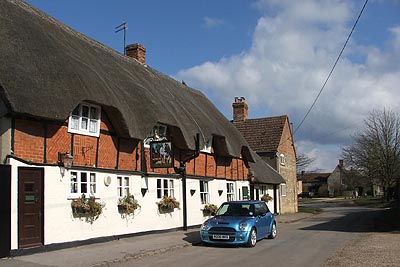 |
 |
|||
|
|
 West
Hanney West
HanneyOriginal Home of the Fettiplaces Hanney is a Saxon name meaning 'Cock Island'. It refers to the land between the Childrey and Letcombe Brooks where wild birds lived. It may have been a place of some importance in those days, for, in 2009, a metal-detectorist discovered the shallow grave of a 7th century noblewoman near the village. It's even been suggested that she was a Princess of the Gewissae (the first of teh Saxon tribes to settle in Britain). She wore a beautiful gold filligree-work brooch inlaid with garnets. She probably lay in a large cemetery, but the homes, where these dead Saxons lived, are, so far, unlocated. By the time of the Domesday Survey (1086) West Hanney was one of the many estates held by Walter Giffard, the Earl of Buckingham, though he probably never even visited. Of the male inhaitants, there were fourteen villeins (unfree peasants with their own land), eight cottagers and four slaves. It had two mills and a Saxon church where Turold was the priest. There were also several other estates in the parish. Today, West or Church Hanney is an attractive village with a good number of 17th century buildings, centred on a small green surrounded by the parish church, West Hanney House and the Old Dower House. West Hanney House (1727) is good example of a rural Georgian Baroque house, of the type characteristic of the Vale of the White Horse. The Old Dower House (1517) was the dower house of the Yate family, used as a home for the widowed mothers of the lords of the manor of Lyford Grange. Its chimney-stack features the Yate rebus of a barred gate. Lyford, to the north-west of the village, and East Hanney, to the east, were both once in the parish of West Hanney. Lyford Grange is where the Jesuit preacher, Edmund Campion, was arrested in 1581. The 13th century church is a funny looking building, mostly due to the bizarre wooden bell-turret on top of the stumpy tower. It was only put up there in 1957. The building houses a medieval perpendicular screen and stairs to the old rood loft that once stood above it, but its main feature is the chancel floor which is covered in memorial brasses to members of local Tudor families: the Ayshcombes of Lyford Manor, the Wellesbornes of East Hanney Manor, Humphrey Cheney of Prior's Hanney Manor and Christopher Lytcot of Swallowfield House (why was he buried in Hanney?). There is also a late 14th century priest. The place has, however, lost its brass to John Fettiplace of North Denchworth Manor and his wife (1510). On the western boundary, just within the parish, stands what is left of the deserted medieval village of North Denchworth. Grange Farm is believed to be the site of the old manor, though a moat down by the Childrey Brook may have enclosed the medieval house (this is in Denchworth parish). This was the home of the Fettiplaces, a famous family. They were a most prolific family who went on to own some forty-nine different Berkshire manors, as well as many in Oxfordshire. Hence: The Traceys, the Lacys and
Fettiplaces But they started out here. Adam Fettiplace, the Mayor of Oxford, rented Wantage Manor from Fulk FitzWarin in 1245. Finding that he liked North Berkshire, he bought North Denchworth eighteen years later.
|
|||
| © Nash Ford Publishing 2001. All Rights Reserved. This location is now administered by Oxfordshire County Council. | ||||


